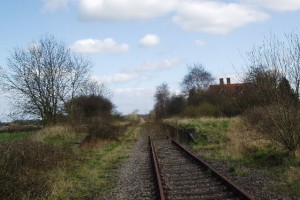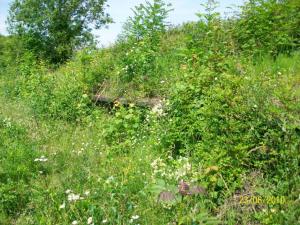
In the early 1980s, I cycled there. A hot day: I remember leaning my bike against a barbed wire fence, the kick of the aspartame from my diet cola and the long, vertiginous note of swifts flying too high above us to see. Â Britain’s barbed wire fences have slipped away in the night and are to be seen no more, but the station here had been closed for the whole of my lifetime and has been closed another lifetime since.
Verney Junction was in the middle of nowhere at the best of times, and the best of times in this case meant 1899-1914. When I was there, it was just one more relic of a country that seemed to have died, abruptly, taking its industry and history and values with it, at some point between the Chatterley Ban and etc.; railways were a childhood interest of mine, and so, as I grew up, decay and decline would prove significant themes.
Long themes, too: the centenary of World War One will mark, as an utter side issue of course, 100 years of nostalgia for the railways’ lost past. Few things in British life have spent longer not being what they once were.
Verney Junction is the ultimate example of all that: it used to be on the Metropolitan Line, and some classify it as a disused Underground station, but it was also on the Great Central Main Line, and served the cross-country route between Oxford and Cambridge. It’s not fallen glamour, but it’s fallen something.
People associate railway building with the Victorians, and they associate the Victorians with confidence, ability, success and moral strength. The Great Central arrived at Verney Junction in 1899, bound for Marylebone, building its line in accordance with the new, larger Continental loading gauge and possessing ambitions for a Channel Tunnel. Nearby, the Great Western Railway was building its new main line to the Midlands and its cut-off fast route to the West.
The conventional account would have it that that was what the Victorians did. A disastrous war and some ill-defined errors thirty years on and we had the Great Crash, then another war and railway nationalization and railway decline and leaves on the line (tinkle of polite laughter).
But the reason for so much railway building at the very end of the nineteenth century, after a quarter of a century of relative inactivity, is a question in itself. And it relates to something else that’s forgotten: among survivors of the 1929 Crash and Great Depression there were older voices who’d say, yes, this is bad, but the real depression was in the 1870s, and you’d see remembered fear cross their faces.
Because we’ve almost completely forgotten the 1873 panic and what followed. Some historians call it The Long Depression and extend it back to the American Civil War, but most would place its origins in a later, shorter, smaller war: that between Prussia and France in 1870. In the aftermath, Germany abandoned the silver base for their currency, and the knock-on effects worldwide interacted with other factors to cause what was known as The Great Depression until a later Great Depression intervened.
There’s a modern feel to much of what followed. European currencies pegged themselves to each other – Â a process that had also begun after the American Civil War and which would endure until 1927. Protectionism and beggar-my-neighbour economics became the norm. For almost half of Victoria’s reign, the free trade approach the Conservatives in power at the time of my Verney Junction visit thought typical of the nineteenth century and responsible for its success simply didn’t hold sway.
Even when things began to turn around at the century’s end – heralding renewed railway building, just in time for the invention of the automobile to disrupt the country’s future in unimaginable ways – there were notes of incompetence and cynicism that we scarcely associate with top hats and laissez-faire, as railway historian David Turner reminds us.
And Tony Blackburn? Â I arrived at Verney Junction a lifetime too late, but Tony was in at the death of it all:

We had the remains of this when I was growing up. And tales of drunks plummeting to their deaths.
http://myweb.tiscali.co.uk/hstchg/railway4.htm
Here’s a bit more.
http://en.wikipedia.org/wiki/Solway_Junction_Railway
The plummeters had evidently failed to hold their drink so sympathy for them was a bit limited, but was freely extended to their relicts and bairns.